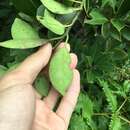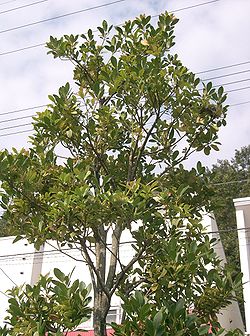fi
nimet breadcrumb-navigoinnissa


Ilex integra, the elegance female holly,[1] also called mochi tree, is an ornamental tree of the holly genus, which is native to parts of Asia, including Korea; Taiwan; the mid-southern regions of China; and Honshu, Shikoku and Kyushu in Japan. Its flower is light yellow.[2][3] The species was botanically described in 1784.[4]
The bark of the Ilex integra is an ingredient in birdlime, and it is also sometimes planted as a sacred tree.[3]
Ilex integra, the elegance female holly, also called mochi tree, is an ornamental tree of the holly genus, which is native to parts of Asia, including Korea; Taiwan; the mid-southern regions of China; and Honshu, Shikoku and Kyushu in Japan. Its flower is light yellow. The species was botanically described in 1784.
Ilex integra, appelé communément houx à feuilles entières[1], est une espèce du genre Ilex, famille des Aquifoliaceae.
Ilex integra peut être un arbre qui atteint 6 mètres de haut[2].
Ilex integra est un arbre à feuilles persistantes. Son écorce grise est lisse.
Ses feuilles vert foncé et coriaces sont elliptiques avec des marges entières, atteignant 8 centimètres de long et 4,5 cm de large[2].
Ses fleurs jaunes sont à quatre lobes, en forme de croix, jusqu'à 7 millimètres de diamètre et sont disposées en cymes[2].
Son fruit est une drupe rouge, jusqu'à 12 mm de diamètre et persiste sur la plante pendant les mois d'hiver[2].
Des plantes mâles et femelles doivent être plantées pour que les plantes femelles puissent produire des baies[2].
Ilex integra se trouve au Japon (Honshū, Shikoku, Kyushu[3]), dans le sud de la Chine[2], à Taïwan et en Corée[4].
Dans son habitat naturel, des reliefs proches de la mer[3], il pousse dans les fourrés et les bois[2].
Ilex integra vient d'un climat tempéré[4]. Il préfère les sols humides, fertiles et bien drainés ; il n'aime pas les sols humides[2].
Ilex integra servait pour la chasse à la glu[3]. Il est aujourd'hui une plante ornementale[5].
Ilex integra, appelé communément houx à feuilles entières, est une espèce du genre Ilex, famille des Aquifoliaceae.
Ilex integra là một loài thực vật có hoa trong họ Aquifoliaceae. Loài này được Thunb. mô tả khoa học đầu tiên năm 1784.[1]
Ilex integra là một loài thực vật có hoa trong họ Aquifoliaceae. Loài này được Thunb. mô tả khoa học đầu tiên năm 1784.
全缘冬青(学名:Ilex integra)为冬青科冬青属的植物。分布于日本的本州、四国、九州与朝鲜、台湾岛以及中国大陆的浙江等中南部地区,生长于海拔1,320米至2,150米的地区,见于海滨山地,目前已由人工引种栽培,常种植於公园、庭院中。雌雄異株,花期春季,花瓣淡黄色,晩秋果实成熟,为深红色。
全缘冬青(学名:Ilex integra)为冬青科冬青属的植物。分布于日本的本州、四国、九州与朝鲜、台湾岛以及中国大陆的浙江等中南部地区,生长于海拔1,320米至2,150米的地区,见于海滨山地,目前已由人工引种栽培,常种植於公园、庭院中。雌雄異株,花期春季,花瓣淡黄色,晩秋果实成熟,为深红色。
雄花

モチノキ(黐の木)とはモチノキ科の植物の一種。学名:Ilex integra。別名ホンモチ。
本州、四国、九州、南西諸島、台湾、中国中南部に分布する雌雄異株の常緑高木であり、株単位で性転換する特性がある[1]。 開花期は春、花弁はうすい黄色でごく短い枝に束になって咲く。雄花には4本の雄蕊、雌花には緑色の大きな円柱形の子房と退化した雄蕊がある。晩秋に直径1センチメートルほどの球形の赤い果実をつける[1]。
葉がクチクラ層と呼ばれるワックス層に覆われていることから塩害に強い。寒気の強い内陸では育ちにくいため、暖かい地方の海辺に自生する[1]。刈り込みに強いことから公園、庭などに植栽される。
モチノキにはモチノキタネオナガコバチという天敵が存在する[1]。このコバチは夏に発育中の種子の中に産卵し、幼虫と成って越冬する。幼虫は実の色を操作する能力があり、秋になれば本来赤くなる実を緑のままにすることで、実が鳥に食べられる事態を避ける。鳥に食べられる事によって繁殖するモチノキにとって、コバチの産卵は繁殖の妨げとなる。
モチノキは花粉を受粉しなくても種子を形成し、果実まで成熟することができる能力があり、調査によって未受精の種子は全体の3割に及ぶことが判明している[1]。コバチは受精した種子にしか産卵しない特性があり、時間と労力をかけて産卵管を挿入しても、未受精の種子だった場合は産卵せずに抜いてしまう。未受精の果実は発芽しないため繁殖の役には立たないが、産卵に無駄なコストをかけさせることでコバチの繁殖を妨害する対抗手段となっている[1]。
樹皮から鳥黐(トリモチ)を作ることができ、これが名前の由来ともなった[2]。まず春から夏にかけて樹皮を採取し、目の粗い袋に入れて秋まで流水につけておく。この間に不必要な木質は徐々に腐敗して除去され、水に不溶性の鳥黐成分だけが残る。水から取り出したら繊維質がなくなるまで臼で細かく砕き、軟らかい塊になったものを流水で洗って細かい残渣を取り除くと鳥黐が得られる。
モチノキから得られる鳥黐は色が白いため、ヤマグルマ(ヤマグルマ科)を原料とするもの(アカモチ)と区別するために「シロモチ」または「ホンモチ」と呼ぶことがある。
御神木として熊野系の神社の中にはナギの代用木として植えている場合がある。
감탕나무는 감탕나무과에 속하는 늘푸른넓은잎나무이다.
감탕나무는 끈끈한 물질이 있는 나무라는 뜻에서 단맛이 나는 국물을 나타내는 감탕, 또는 새를 잡거나 나무를 붙이는 데 쓰는 갓풀을 뜻하는 감탕에서 유래된 이름으로 추정된다. 다른 이름으로 떡가지나무, 끈제기나무가 있다.[1]
주로 산지에서 자라며 한국에서는 전남·경남·경북·제주도·울릉도 등지에 분포하고 있다. 높이는 10m 정도이다. 길이 5-8cm로 양끝이 뾰족한 타원형을 하고 있으며 혁질이고, 1cm 안팎의 잎자루를 가지고 있다. 꽃은 황록색으로, 봄이 되면 수꽃은 몇 개씩 뭉쳐서 피며, 암꽃은 잎겨드랑이에 1-2개씩이 달린다. 이때 각각의 꽃은 4개의 납작한 꽃잎을 가지고 있으며, 수꽃은 4개의 수술을, 암꽃은 1개의 암술을 가지고 있다. 열매는 핵과로 다음해 1월에 붉게 익는다. 암수딴그루로 암나무에는 가을에 붉은 열매가 가득 열린다.
매연이나 염풍에 강하고 대기오염에도 잘 견디는 강건한 나무이다. 나무껍질을 물 속에서 썩히면 고무질 같은 끈적끈적한 물질이 남는데 이것을 한방약재로 사용한다.